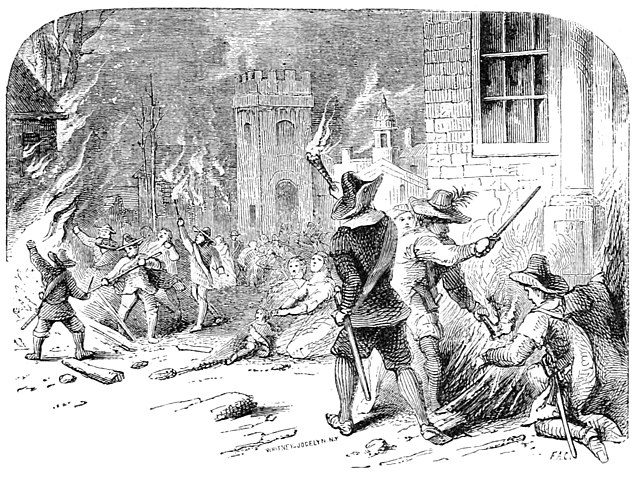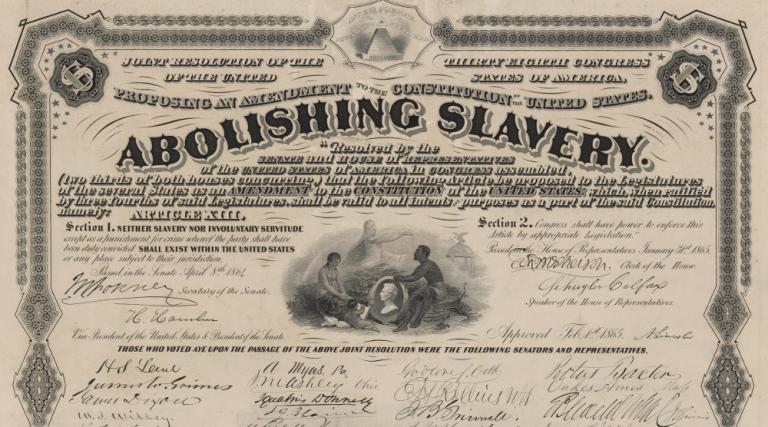Now, let me be clear: I’ve no hate for Juneteenth. A federal holiday right around the Summer Solstice, dedicated to the idea of freedom? Sure, sign me up.
But when the Juneteenth federal holiday was established, I was disappointed at the number of people claiming that the original Juneteenth celebration marked the end of slavery in the United States. This erases the history of the Thirteenth Amendment, whose anniversary falls on December 18th (conveniently near the Winter Solstice), and badly distorts the history of slavery in the United States.
A Brief History Of The Origins of American Slavery…
Let’s briefly set the background. Slavery was part of human society from the earliest civilizations; the most ancient laws we have record of, laid down by the Sumerian king Ur-Nammu somewhere around 2000 or 2100 BCE, include rules regarding fugitive slaves.
Ethnicity had little to do with it — people enslaved members of their own societies, of other societies of their same ethnic group, and of societies of other ethnic groups. (The word “slave” is cognate with “Slav”, from the days when Moors enslaved Slavic people.)
While slavery has been an accepted constant in human history until recently, its forms have varied widely. In some societies slaves were roughly the same status as domestic animals, while in classical Athens, proto-fascist Plato complained that slaves had nearly equal social status to citizens.
And slavery in Britain’s American colonies and the early United States was a particularly execrable form of the vile institution.
Slavery existed in Medieval Europe, but was largely displaced by serfdom starting from about the 13th century. Serfdom was also a form of unfree labor, but serfs were bound to a feudal lord (sometimes directly but more often via being bound to the land) who had some obligations to them, while a slave owner had no more obligation to a slave than to any other property.
By the Elizabethan period, serfdom in Britain was extinct in all but a handful of cases. While the labor situation by the 17th century was far from a socialist paradise, British workers had significant rights.
So when Britain started to set up colonies in the America and needed exploitable workers to clear land and farm tobacco and sugar, they couldn’t just conscript British workers and send them over en masse.
The British colonial bosses had a go at enslaving Native Americans, but this had difficulties; Old World diseases tore through the Native population, Natives weren’t familiar with Old World agricultural methods, and any enslaved Native who escaped could flee to the protection of their own people.
They did force plenty of British convicts and debtors, as well as prisoners of war, over to the colonies as forced labor; and some populations, such as the “Scots Irish” from Ulster, were getting enough of a raw deal in the British isles that selling themselves into indenture to get to the colonies looked like an opportunity for something better. (With broad caveats, we might compare such groups to refugees arriving in the US today: voluntary arrivals, but fleeing conditions that if not technically compulsion are very strong motivators to leave.)
But this wasn’t enough manpower. So they turned to the slave markets of Africa, often purchasing slaves from Dutch traders.
Now, the British, Dutch, and other Europeans did not do much of the actual enslaving. They were not that bold; they mostly bought slaves from Africans. But the imperialist’s demand for slaves expanded and transformed the institution of slavery in Africa, making it even more inhumane.
In the colonies, African slaves at first had it worse, but not a lot worse, than British convicts and indenturees. Africans and Europeans mixed somewhat freely. Enslaved people and those subject to other forms of forced labor often worked together and mingled socially. Boundaries were fluid.
Until, that is, Bacon’s Rebellion.

Bacon’s Rebellion
In 1676, wealthy colonist Nathaniel Bacon organized a militia of white and black indentured servants and enslaved black people, in opposition to Virginia’s governor, William Berkeley (a relative of his).
Now, lest this sound like a glorious interracial Kumbaya moment, we must note that the main point of disagreement between Bacon and Berkeley was treatment of Native Americans: Bacon wanted to retaliate for Native raids, wipe them out in Virginia, and take the land, while Berkeley worried that this would unite the Natives in a war against the colonists.
A power struggle between Bacon and his inclusive militia on one side, and Berkeley and the rest of the Virginia bosses on the other, ensued. It escalated to armed conflict, and in September 1676, Bacon’s militia burned the colonial capital of Jamestown to the ground.
The rebellion ended soon after that when Bacon died of a fever. But the Virginia bosses were shaken up by the actions of this early Rainbow Coalition.
They had to find a way to keep these workers apart.
And so they invented “white people” and “black people”.
British people didn’t widely refer to themselves as “white” before the mid-1600s. At first the term was only used to refer to the fair skin of elite English women, who were preserved against any form of outdoor labor, but didn’t apply to men. (Even an upper class man might have to go outside to supervise the happenings on his property.)
But after Bacon’s Rebellion, the colonial government began to treat people of African and European descent radically differently, and to refer to “white” and “black” people in their laws. They made the slavery of African-descended people hereditary, while giving a tiny bit of power (not much, but some) power to European-descended farmers.
As historian Ira Berlin put it,
Now what is interesting about this is that we normally say that slavery and freedom are opposite things -that they are diametrically opposed. But what we see here in Virginia in the late 17th century, around Bacon’s Rebellion, is that freedom and slavery are created at the same moment.
…
…In Virginia prior to Bacon’s Rebellion we had a much more open system. We have black planters and white planters, black indentured servants and slaves, we have white people who are indentured servants and living in un-freedom.
…
When we move into the post-Bacon’s Rebellion world where slavery and the plantation economy are in place, where black people are arriving in large numbers from Africa, the view of black people changes very rapidly. It is not simply slavery that transforms notions of race. It is this plantation slavery, the advent of the plantation and disciplined, exploitative labor that begins to transform notions of race.
So in summary:
- slavery existed long before European colonization of the Americas; but
- European colonization of the Americans drove a tremendous demand for African slaves, transforming an already vile institution for the worse; and
- the British colonies in particular racialized slavery, creating the foundations of “race”, of “blackness” and “whiteness”, as we know them today.
But this happened a century before the American Revolution. It was a sin of the the British Empire, not of the United States which ultimately went to war to win independence from it.
It has become a cliche to call slavery the US’s “original sin.” The thing about the doctrine of original sin, though, is that it holds that a human being is irrevocably, metaphysically stained by the actions of distant ancestors.
As a Zen Pagan, I hold no truck with that idea.
I’d like to suggest a different metaphor, one that’s perhaps a pop-psychology cliche but still might be useful here: “inter-generational trauma”. While the actions of distant ancestors do not leave some metaphysical mark on us, those of our own direct parents and caregivers do leave an imprint.
Such “inter-generational trauma” is not a metaphysical stain, and its roots are not in the child; but it is the responsibility of children grown to adults to squarely face the inherited trauma, process it, and get beyond it to live responsibly.
…And Of Its Continuation
When the American colonies won their independence from Britain, this racialized form of slavery was part of their inheritance. The conflict between that inheritance and the lofty “All men are created equal” rhetoric of the Revolution was not lost on all of the Founders.
As was often the case, Benjamin Franklin exemplified what is was to be an American of the time.
As a young man, Franklin owned slaves, and his newspapers carried ads for slave auctions. But he also he published Quaker anti-slavery pamphlets.
By 1787, Franklin had become an ardent abolitionist and took office as president of the Pennsylvania Society for Promoting the Abolition of Slavery. This Society had originally been formed shortly before the Revolution, and was revived and reorganized in 1784.
With Franklin at the helm the Society adopted a constitution whose preamble is a remarkable clear expression of the evils of slavery:
It having pleased the Creator of the world, to make of one flesh all the children of men, it becomes them to consult and promote each other’s happiness, as members of the same family, however diversified they may be, by colour, situation, religion, or different states of society. It is more especially the duty of those persons, who profess to maintain for themselves the rights of human nature, and who acknowledge the obligations of Christianity, to use such means as are in their power, to extend the blessings of freedom to every part of the human race; and in a more particular manner, to such of their fellow creatures as are entitled to freedom by the laws and constitutions of any of the United States, and who, notwithstanding, are detained in bondage, by fraud or violence.— From a full conviction of the truth and obligation of these principles, — from a desire to diffuse them, wherever the miseries and vices of slavery exist, and in humble confidence of the favour and support of the Father of Mankind, the subscribers have associated themselves, under the title of the “Pennsylvania Society for Promoting the Abolition of Slavery, and the Relief of free Negroes unlawfully held in Bondage, and for improving the condition of the African race.”
It was just a month after enacting this constitution for the Society that Franklin joined the Constitutional Convention in Philadelphia. And we know how that ended: in order to create a strong central government, the states agreed to a devil’s bargain which included the three-fifths compromise, the obligation to return escaped slaves, and the preservation of the trans-Atlantic slave trade for at least two decades.
The situation was inherently unstable, and only 73 years passed between the ratification of the Constitution and the attack by pro-slavery terrorists on Fort Sumter, starting the American Civil War.
…And Of Its Ending
…at least, on paper
It’s widely understood that Abraham Lincoln’s objective in the Civil War was the preservation of the Union, not the end of slavery. As he said, “My paramount object in this struggle is to save the Union, and is not either to save or to destroy slavery. If I could save the union without freeing any slaves I would do it, and if I could save it by freeing all the slaves I would do it; and if I could save it by freeing some and leaving others alone I would also do that.”
When war was engaged, Lincoln saw that third option as a viable strategy. He clearly did not have the legal or Constitutional authority to end slavery, but there was an argument that he did have the wartime authority to seize enemy property.
It was Major General Benjamin Franklin Butler who first came up with this strategy in May of 1861, to justify refusing to return a trio of escaped slaves who were being forced to build a Confederate artillery emplacement. Butler happened to be a lawyer, and knew that military laws allowed the seizure of enemy property that was being used for hostile purposes.

The official legal status of these “contrabands” may have been ambiguous — were they property? Or freed humans? Lincoln and his commanders tried to avoid the question. But their de facto status was miles above slavery, and enslaved people began to flock to Union troops wherever they could.
Finally, Lincoln realized that this strategy would let him deal a blow to the Confederacy and to the institution of slavery, without requiring any change to the Constitution — or slave-holders in Union states to free their slaves. The Emancipation Proclamation applied only to “persons held as slaves within any state, or designated part of a state, the people whereof shall than be in rebellion against the United States”. It left the status of enslaved people in Union states alone.
Of course, as a practical matter, such a proclamation could only be meaningful in territory controlled by Union troops. Thus, as the war progressed, enslaved people in different parts of the Confederacy achieved effective emancipation at different times.
And after the war, in many communities those different times came to be celebrated with local Emancipation Day commemorations.
In Georgia, for example several different days were taken as the appropriate anniversary. In Savannah, Emancipation Day was celebrated on January 1, the day Lincoln issued the final version of the Proclamation. On the other hand, enslaved people in Thomaston, a town in Upson County, got the news on May 29, 1865, and held a commemoration each year around Memorial Day from 1866 onward — considered the longest-running celebration of its kind.
Tennessee’s August 8th Emancipation Day commemorates the day in 1863 when the state’s Military Governor Andrew Johnson freed his personal slaves. (As the state had seceded but was under Union military control, the Emancipation Proclamation didn’t directly apply.)
In Washington DC, the April 16 anniversary of the 1862 Compensated Emancipation Act, which freed the slaves of the District, is a local government holiday.
And of course, on June 19, 1865, black people in Galveston, Texas, learned of the Emancipation Proclamation, and started commemorating the day with one heck of a party — a tradition which spread widely. The 1968 Poor People’s Campaign boosted Juneteenth when it held a “Solidarity Day” event which drew over 50,000 people in Washington, D.C, and in recent years it became a nationwide movement and finally a federal holiday.
But with all respect to the people of Galveston, slavery did not end in the United States on June 19, 1865.
We’ll put aside for now the ways in which convict leasing, sharecropping, prison labor, and so on arguably made the end of slavery less than effective (“not so as you’d really notice it, of course — just sort of on paper”, as George Carlin put it). The fact is that chattel slavery of African Americans continued after the war in states not covered by the Emancipation Proclamation and which did not act on their own to eliminate the practice.
Most significant was Kentucky, where about 65,000 people remained enslaved and some slaveholders believed that slavery would survive in the post-Civil War era; they continued to buy and sell human beings even after the end of the war. Additionally, hundreds of people remained enslaved in Delaware, and sixteen people in New Jersey had not been freed by that state’s “gradual emancipation” policy.
They would have to wait until the Thirteenth Amendment took effect.
The Amendment was in progress even before the war was over, and passed the Senate on April 8, 1864. It took three votes to clear the House, however, and was not passed there until January 31, 1865.
On December 6, 1865, Georgia ratified it, becoming the 27th state to do so and giving it the three-quarters of the states required.
And finally on December 18, 1865 (three days before the Winter Solstice), the Thirteenth Amendment was certified by Secretary of State William Seward, becoming officially and undeniably part of the Constitution of the United States, and freeing those tens of thousands of remaining slaves.
Much work remained, and still remains, to be done to deal with the legacy of that national “inter-generational trauma” of racialized slavery. The glorious Fourteenth, with its guarantees of equal protection and birthright citizenship, wouldn’t become part of the Constitution until 1868 — and wouldn’t be meaningfully enforced until after the 1960s civil rights movement.
While racial animus is now a discredited minority view, the legacy effect of generations of social and economic inequality continue to impact us; and as horrors like the murder of Ahmaud Arbery remind us, active racial bias remains real.
But as of December 18, 1865, the law of the land now denied the legitimacy of an institution that had been with humanity for perhaps as long as civilization itself, and with the United States since its birth.
That is a step worth recognizing.
And so perhaps, when we wish each other “Happy Holidays” in recognition of the number of festivals which occur around the Winter Solstice (remember, axial tilt is the reason for the season!), we should include Thirteenth Amendment Day in that list.














